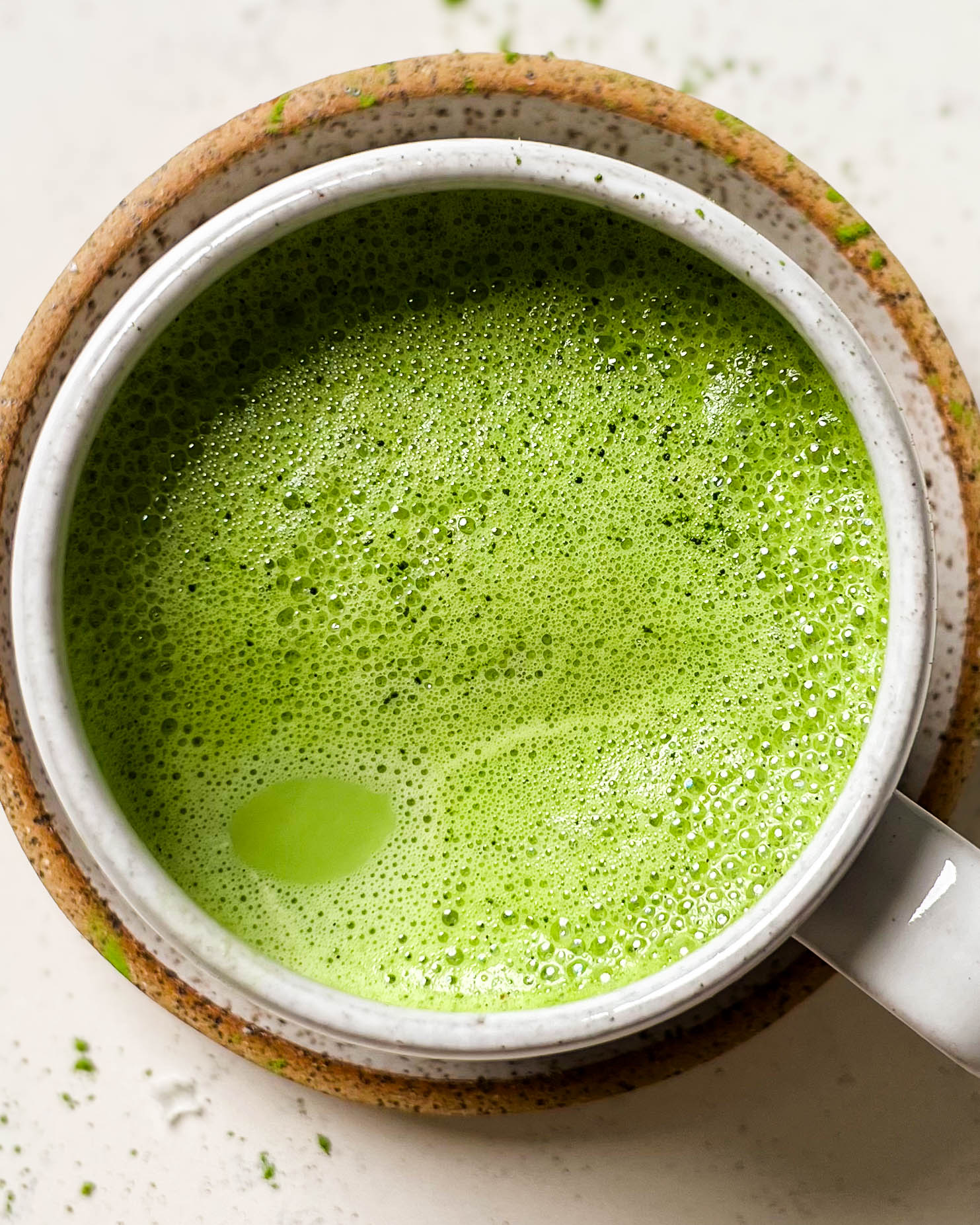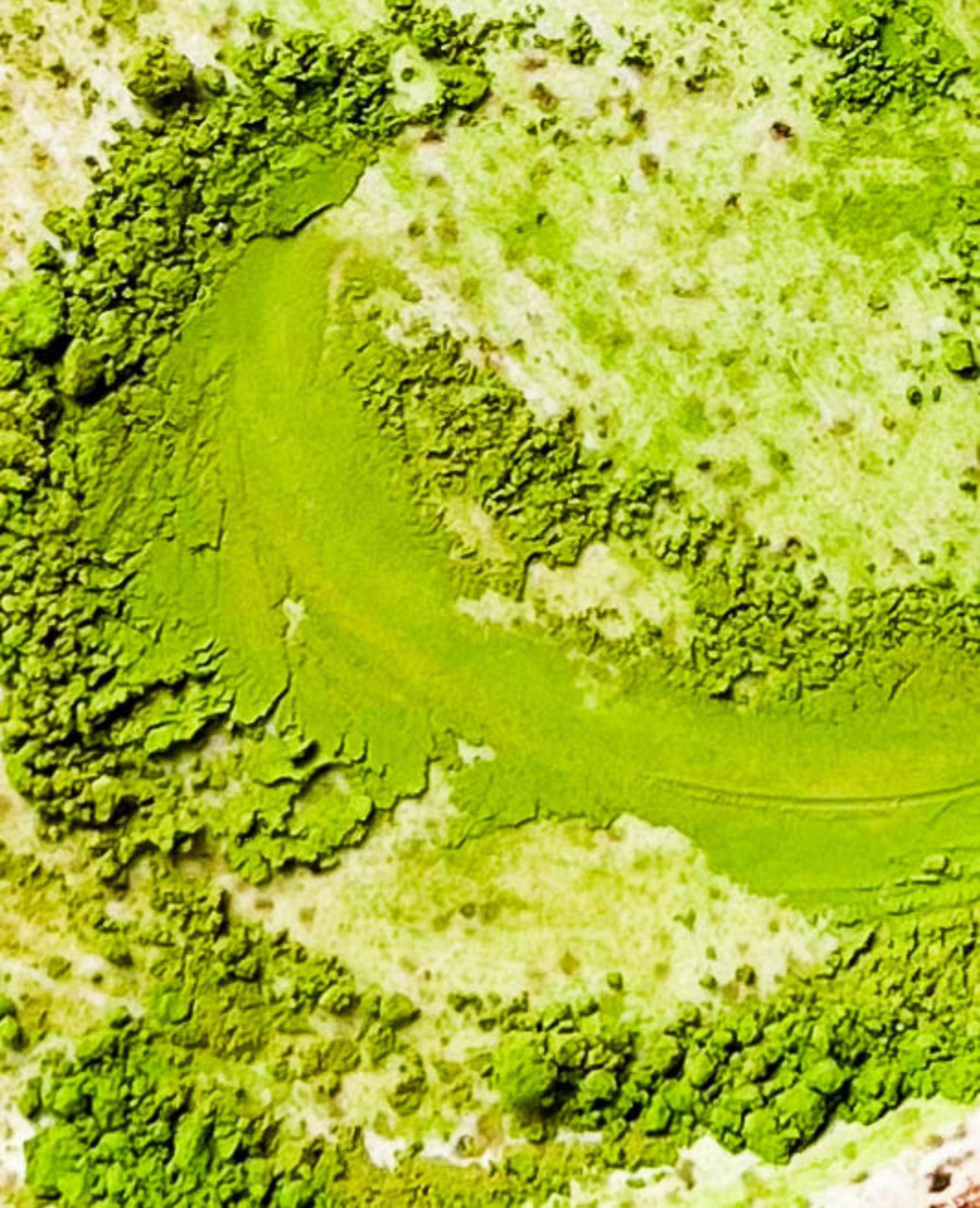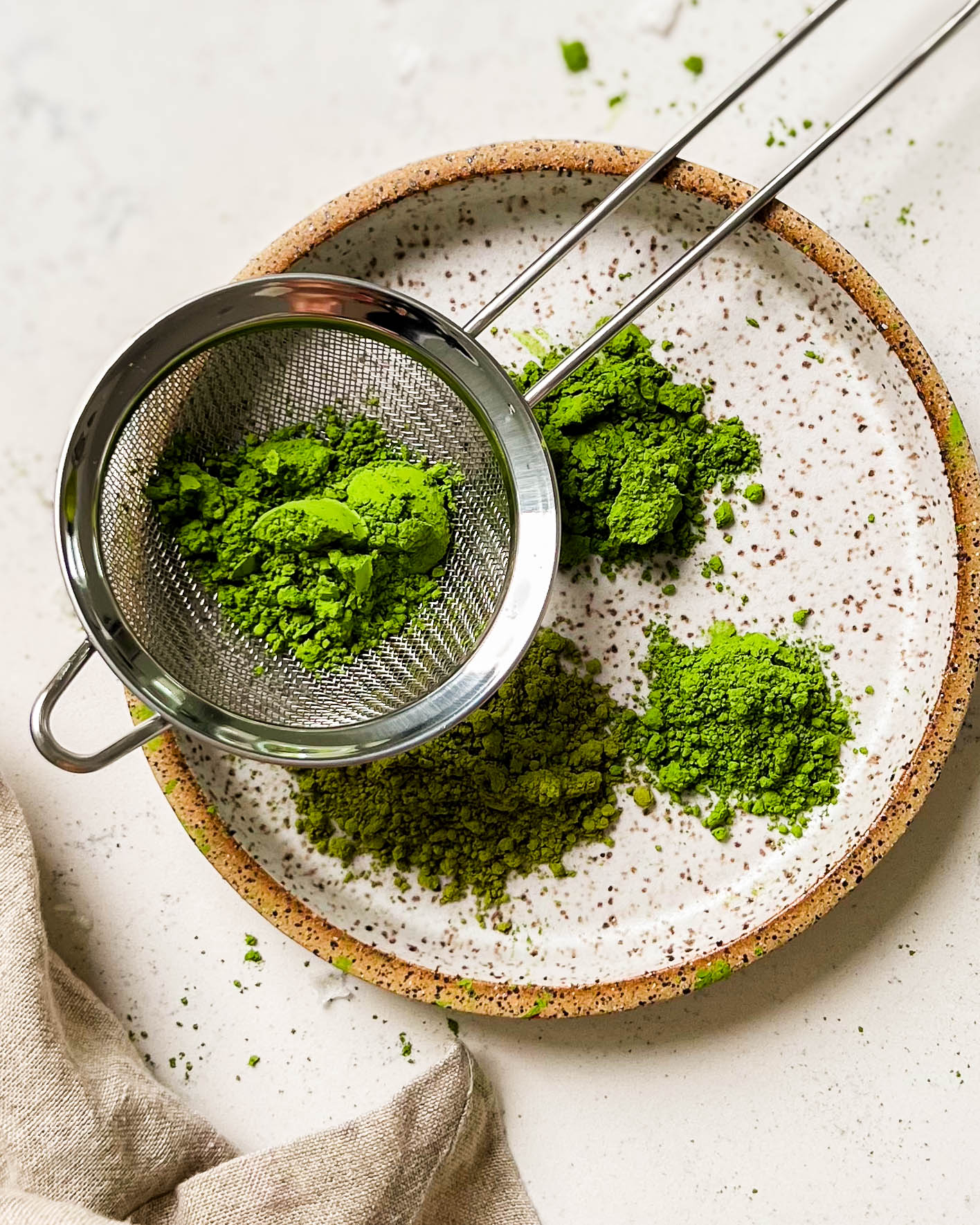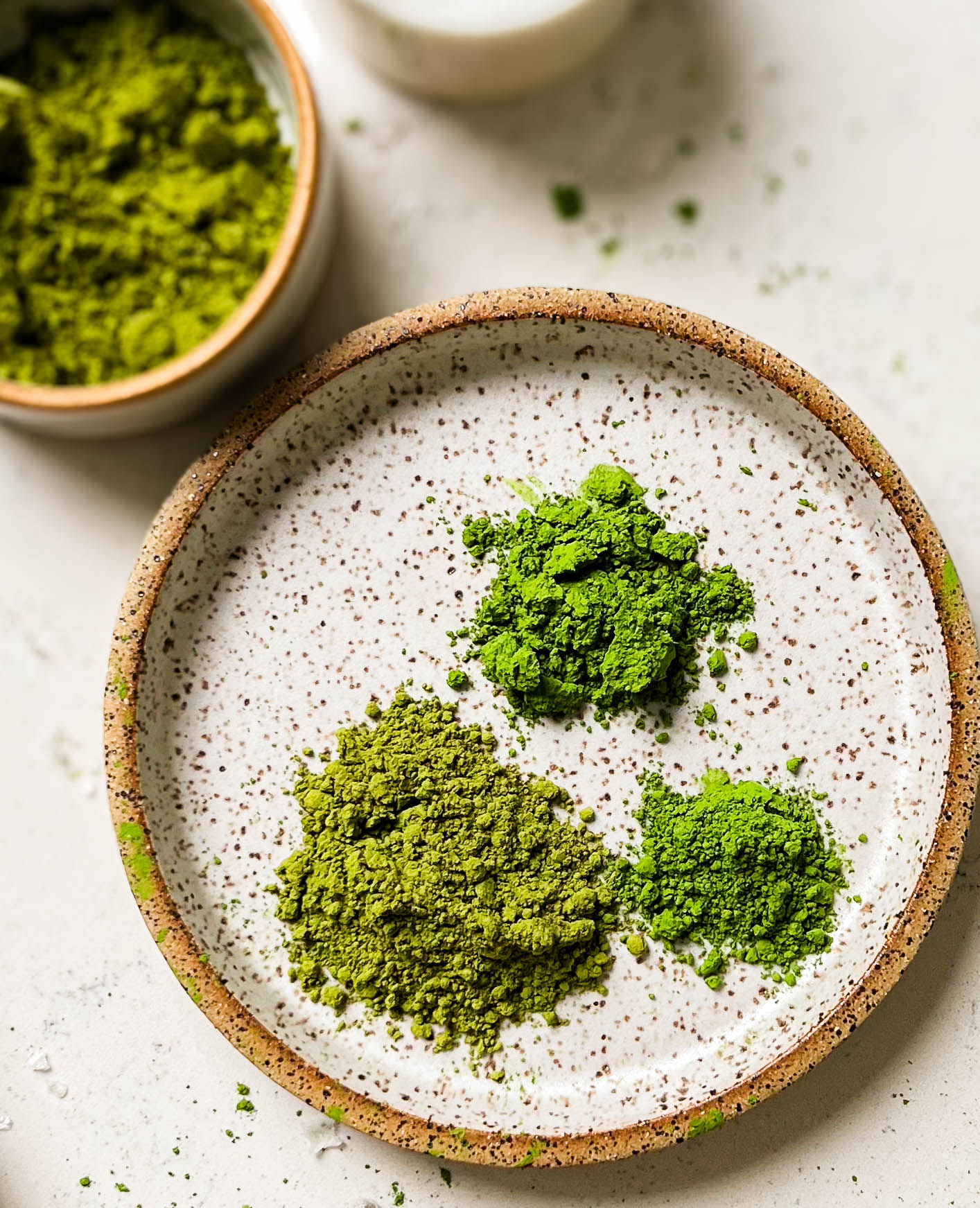The Ultimate Guide to Matcha
As a self-proclaimed matcha addict, I had to put together a matcha guide. From the brands I recommend to the numerous benefits associated with matcha.
Because it’s far more than just ground up green tea.
Ok, let’s dive into matcha 101!

What is Matcha
Matcha is a type of green tea that is made by grinding young green tea leaves into a powder.
Matcha leaves are grown in shade, which increases the amount of chlorophyll content in the leaves – making them full of nutrients. Which in turn makes the flavor less bitter and much brighter and bold. Additionally, the leaves are ground with granite stones in a dark room to preserve the nutrients and prevent oxidation.
Varieties of Green Tea
Ok, so fun fact, matcha actually comes from the same tree as sencha, gyokuro, green tea, genmaicha, hojicha and even oolong and black tea. Crazy right?
The difference in these teas comes down to the time that they’re harvested along with their processing and fermentation methods. These factors will determine the variety of tea you end up with, along with the price and quality of tea.
For reference, the first harvest yields tea leaves that are appropriate for sencha tea, which is brewed tea and ceremonial matcha (this is the best quality). Later in the summer, the second harvest yields culinary matcha which is less nutrient dense and thus a lower grade of matcha. Lastly, the third harvest is typically used for bottled tea, drinks, etc.
But Where is Matcha Grown?
One last thing, the tea leaves for matcha also require a very specific climate for them to be grown properly. They are shade grown tea leaves, most commonly grown in the Shizuoka, Uki, Wazuka and Kagoshima regions of Japan. What makes these regions so ideal for growing tea is the access to shade (duh) and their nutrient rich soil. Additionally, these areas are also known for intense bouts of fog which is important for the tea (too much sunlight imparts a bitterness to the tea).

Caffeine in Matcha vs. Coffee
The age old question of whether matcha is better than coffee. Full transparency, I don’t think one is better than the other, if you enjoy coffee and feel good on it, keep on drinking it.
However, there is no denying that matcha does have some unique benefits that coffee doesn’t have, not to mention the caffeine you get from matcha does affect your body very differently as opposed to coffee.
Essentially, matcha contains L-Theanine which aids in slowing down the release of the caffeine, meaning that you won’t have that crazy caffeine rush and crash you get from coffee. Additionally, L-Theanine in matcha contains EGCG (epigallocatechin gallate) , a powerful catechin, chlorophyll and more. Don’t worry, I’ll get into matcha’s benefits later in this article.
Why is Matcha so Expensive
Essentially matcha requires a lot more involvement, care and skills which ups the price as opposed to regular loose-leaf green tea. Additionally, the grade of matcha that you buy will vary on price depending on the quality of the matcha.
To illustrate exactly why matcha is so expensive, here are the steps involved in making matcha. You’ll realize quickly why that price tag exists.
- Starting off, green tea plants (also known as Camellia Sinensis) are shaded for 25-30 days before the first harvest. The whole intention behind shading the tea plant is to prevent frostbite and boost the nutrient production of the tea leaves by suppressing photosynthesis.
- Once spring hits, it’s time for the first harvest, aka Ichibancha (quite literally means ‘first tea’). This is typically when ceremonial grade tea leaves are picked (the highest grade). The second harvest, Nibancha (meaning ‘second tea’), is around the end of June. This harvest is when culinary grade tea leaves are picked (aka lower grade matcha).
- Immediately after the tea leaves are picked, they’re steamed and dried to preserve the flavor and nutrients. This essentially halts the oxidation process and ensures the flavor of the tea leaves is top tier and the nutrient density is preserved.
- Once this step is done, the tea leaves stems and veins are removed to further improve before they are ready to be ground (this is called Tencha). Tencha, very similar to wine, is aged over the course of months and sometimes even years.
- The leaves are ground on a granite stone, to finally become a powdered green tea, aka matcha. And that’s it! That’s the whole process of matcha, or at least the summarized version lol.

Green Tea vs. Matcha
Essentially, when you use the entire leaf of tea, aka ground matcha powder, you’ll get all the nutrients, rather than a fraction that you would get from steeping the tea leaves.
Matcha Health Benefits
Ok let’s get into some matcha health benefits, specially L-theanine, EGCG and polyphenols (better known as antioxidants).
- L-theanine: Is an amino acid that is better known as umami. It also happens to act as a buffer for helping make you feel relaxed despite drinking caffeine. So instead of feeling crazy and then crashing an hour later (hello coffee), matcha helps you feel relaxed, yet still super alert and energetic without any jitters or afternoon crash.
- EGCG: Also known by its crazy name ‘epigallocatechin gallate, is an antioxidant (specially a flavonoid / catechin) that is naturally occurring in matcha and green tea. And like all antioxidants, EGCG helps fight free radicals (aka cancerous, tissue damaging) and helps inflammation.
- Polyphenols: Also known as antioxidants are renowned for their health benefits and help fight free radicals which are responsible for aging, tissue damage, inflammatory issues and are also connected with cancerous cells.
- Vitamin E: Another antioxidant in matcha that is an essential vitamin for skin and brain function.

Where to Buy Matcha
These are my top three recommended brands for high quality matcha!
- Ippodo Tea: Ippodo is where I source my matcha from. They’re a family owned business that started back in 1717; their matcha is absolutely impeccable. Additionally, they have a variety of different matchas from sweeter light grades to more bold matcha, depending on your preference. I personally love their Ummon matcha for every day drinking!
- Breakaway Matcha: Another great matcha brand similar to Ippodo. The quality, flavor and color of their matcha is impeccable. Their cold brew matcha is my favorite!
- Matchaful: While I don’t personally drink their matcha, they do have quality matcha options at a more affordable price.
Frequently Asked Questions
- Why does my matcha taste bitter? Honestly every single matcha I’ve ever bought from a cafe has sucked to the point that I’ll never buy it outside again. Most of the time the baristas don’t know how to properly prepare matcha. Plus, cafe’s rarely use quality matcha (or ingredients for that matter). Additionally, for profit margins, most cafes use culinary grade matcha which has a bitter undernote and should only be used for baking. Moral of the story, make it at home!
- How to make matcha without a bamboo whisk? I honestly ever taste a difference in using a bamboo whisk vs using a frother (in fact I prefer the frother as it’s easier and makes the matcha more frothy and aerated). I’ll link the frother I use here.
- Why does my matcha look brown? Most likely you’re using a low-grade matcha, such as culinary grade. If you’re drinking the matcha on its own or in a latte, get a ceremonial grade matcha for best results!
- How can you make matcha taste better? All I’ll say is that you need to try my matcha latte recipe here — it will change your opinion on matcha for good!
- Should matcha be kept in the fridge? As long as you store the matcha in a cool and dark place, your matcha will be fine. Any exposure to heat and air will quickly degrade the matcha and nutrient density.
- Should you add milk to matcha? If you have a high quality ceremonial grade matcha, I would recommend enjoying the matcha on its own. Mainly because that matcha will literally taste sweet! However, if you have a lower grade matcha, then yes, absolutely add in some milk and make a matcha latte.

Matcha Recipes
I couldn’t write an entire article about matcha and how freakin good it is without leaving you with a few recipes to make using matcha.
If you have any further questions, leave a comment below or DM me on Instagram @munchingwithmariyah!

Pingback: The Best Iced Matcha Latte | MWM
thank you for sharing your experiences. i always look forward to seeing what you post on Insta, i am leaning more towards plant based foods but the journey is slow and i’m still learning all the changes. i can certainly feel the benefits and slowly i will get there. i know in my heart it’s the right path. how can it not be!! only by research and actually applying the mind to what is being said does it make complete sense to go that route. we are what we eat! I know this is what i want and i just need dive into this wholeheartedly. it will come soon.
thanks and keep posting xx
Awwww legit made my day to read this! I actually started MWM because I felt the benefits of eating a more plant-focused diet and wanted to share my own learnings and recipes with others to help them feel their best as well; hearing this means the world to me. Thank you so much for sharing Wendy!!
Pingback: The Best Hot Matcha Latte
Pingback: Iced Matcha Latte | MWM